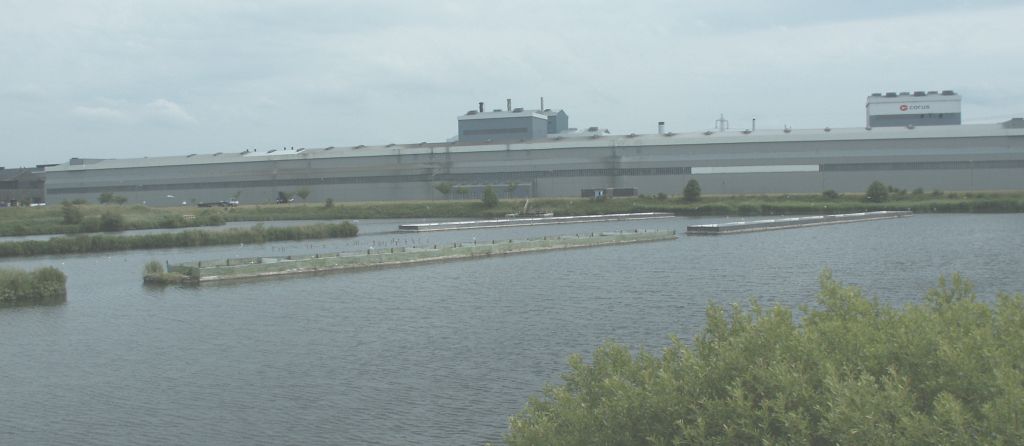Conservation
All of the Group's work contributes to conservation through incorporation of our data into the national databases maintained by the BTO. These pages concentrate on specific conservation projects run by members of MRG.
 The Group's logo was chosen to symbolise our colony of Common Terns
Sterna hirundo on artificial islands (shown below) within the Steel Works complex at Shotton, Flintshire. From humble beginnings on a small floating raft in 1970, the colony has grown to over
650 pairs. This colony owes much to the foresight and the hard work of many Group members, especially Ron and John Birch. When Ron died in 1998 the Group decided to make a donation to the BTO for work on
The Migration Atlas: movements of the birds of Britain and Ireland (publ. T & A D Poyser, London, 2002) and it is especially fitting that the text for the Common Tern is headed 'The analysis of the data for this species was supported by the Merseyside Ringing Group in memory of Ron Birch'.
The Group's logo was chosen to symbolise our colony of Common Terns
Sterna hirundo on artificial islands (shown below) within the Steel Works complex at Shotton, Flintshire. From humble beginnings on a small floating raft in 1970, the colony has grown to over
650 pairs. This colony owes much to the foresight and the hard work of many Group members, especially Ron and John Birch. When Ron died in 1998 the Group decided to make a donation to the BTO for work on
The Migration Atlas: movements of the birds of Britain and Ireland (publ. T & A D Poyser, London, 2002) and it is especially fitting that the text for the Common Tern is headed 'The analysis of the data for this species was supported by the Merseyside Ringing Group in memory of Ron Birch'.

%20(845%20x%20634)%20mod.jpg) Several Group members specialise in ringing Barn Owls Tyto alba, a species specially protected as a 'Schedule 1 species' under the Wildlife & Countryside Act 1981. Large numbers of nest-boxes have been put up
across Cheshire by the local
Barn Owl Conservation Groups. Along with extensive work with landowners on improving habitat for the small mammals on which Barn Owls prey, the provision of suitable nest sites has enabled the Cheshire and Wirral population to increase substantially.
Several Group members specialise in ringing Barn Owls Tyto alba, a species specially protected as a 'Schedule 1 species' under the Wildlife & Countryside Act 1981. Large numbers of nest-boxes have been put up
across Cheshire by the local
Barn Owl Conservation Groups. Along with extensive work with landowners on improving habitat for the small mammals on which Barn Owls prey, the provision of suitable nest sites has enabled the Cheshire and Wirral population to increase substantially.
Click on the photo for more detail of the Barn Owl work.
A Constant Effort Site (CES) was operated for several years at Woolston. This project, part of the BTO's national CES scheme, uses mist-netting at the same sites on dates from May to August to produce annual indices of population (through captures of adult birds) and productivity (through captures of juvenile birds). The strict CES protocol is too inhibiting for many of MRG's ringers and the Group is investigating other possible ways of monitoring populations and productivity through a Measured Effort Scheme; it is too early to say whether the results are valid.
MRG members contribute to the BTO's Retrapping Adults for Survival (RAS) project on Pied Flycatchers. In this project, part of the BTO's national RAS scheme, adult Pied Flycatchers using nest-boxes are trapped every year. Assuming that birds are faithful to a breeding area from year to year, the annual survival can then be calculated.
With our longstanding interest in wildfowl and waders, MRG has been an active member of the Mersey Estuary Conservation Group and the Dee Estuary Conservation Group ever since their formation.
We collaborate with the University of Liverpool Veterinary School at Leahurst, assisting with ringing demonstrations to students in veterinary conservation medicine, and in 2004 started a research project on disease in wild bird populations. This project, entitled 'The role of wildlife in the epidemiology of campylobacteriosis, salmonellosis and VTEC infections', is part of a major programme funded by DEFRA, the UK Government's Department for the Environment, Food and Rural Affairs. Faecal samples are taken from birds caught on a number of farms and the prevalence of enteric zoonoses (organisms living in the gut and transmitted by animals) is compared with that in small mammals trapped on the farms and in farm animals themselves. Results of some of these studies have been published.
Some members of the Group are pursuing in-depth studies of special species, including Woodpigeon Columba palumbus, Pied Flycatcher Ficedula hypoleuca, Sand Martin Riparia riparia, Grey Heron Ardea cinerea, Little Tern Sterna albifrons, Swift Apus apus, Siskin Carduelis spinus and Wood Warbler Phylloscopus sibilatrix. Results of some of these studies have been published and others are still in progress.
Ringing at Oxmoor Local Nature Reserve, Runcorn, 2002-2009 has been summarised in a report available to download here.